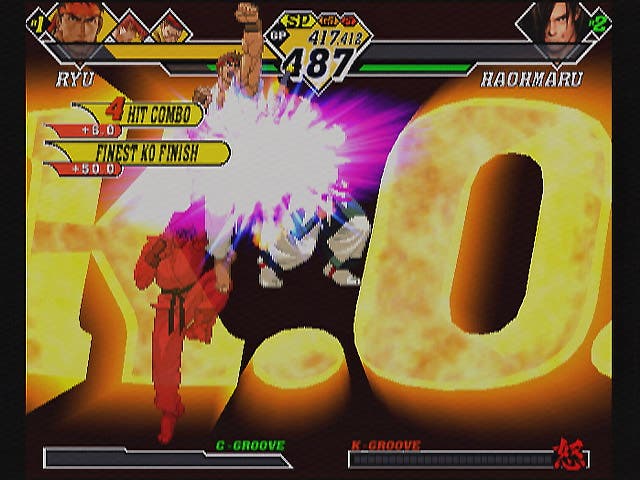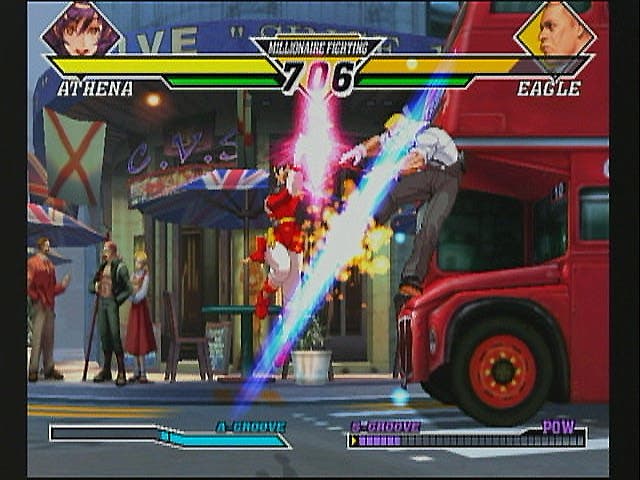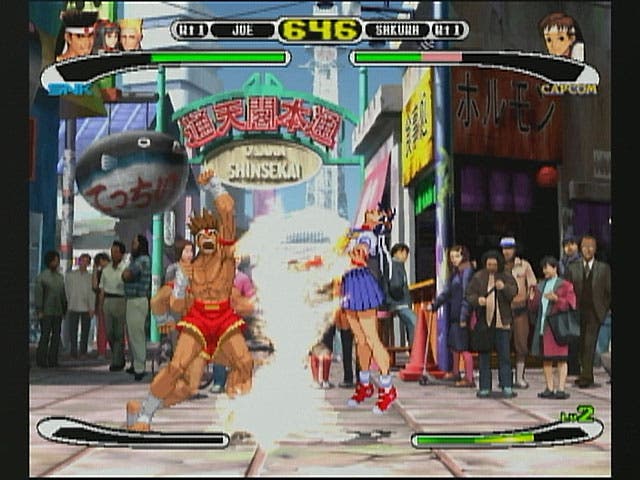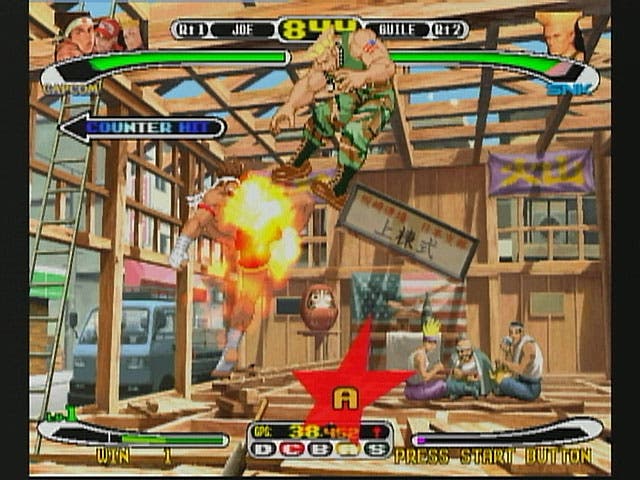Capcom Vs. SNK 2 : Mark of the Millennium
Review - another update to another Capcom beat 'em up franchise. With SNK gone, it might be like this forever

Killin' in the name of...
Capcom Vs. SNK 2 : Mark of the Millennium for the PlayStation 2 is virtually the same game that was released on the Dreamcast recently. It features a crossover of Capcom and SNK-bred characters, and for all intents and purposes it's Street Fighter with optional knobs. As far as graphics, sound, storyline and longevity go, there is very little new here, and as far as gameplay modes and the feature set go the only changes are tweaks, along with some extra characters and gameplay mechanics lifted from older iterations of Street Fighter. That makes it a very difficult game to review because, firstly, there is so little to discuss, and secondly, the kind of subtle advances found in Capcom Vs. SNK 2 : Mark of the Millennium compared to its predecessor are the sort of minutiae that only a determined, lifelong fan of the 2D beat 'em up genre could identify. Frames of animation removed from certain moves perhaps, or increased speed at a particular point of a popular combo, or whether a new background is derived from a competitor's product and is actually a complimentary gesture from one development team to another.

Getting down to it
Whether you can get over the fact that it's a controversial point release for propeller heads is entirely the point, of course. Everybody should own a decent 2D beat 'em up, and Capcom Vs. SNK 2 is certainly that, but being at the pinnacle of a genre so utterly dominated by a single franchise means that it need not justify its release with startling changes, it can get away with being 110% of last year's release. And as the treasury likes to tell us, percentages can come from anywhere, but they rarely mean anything to anyone. If there's a point to all this, then it's this: if you own a 2D beat 'em up released from about 1999 onwards then you should not buy Capcom Vs. SNK 2, unless you also own every other 2D beat 'em up released during that time. Unless you know you will appreciate the adjusted suspension and thicker tyres, don't buy them. This game is for veterans of the genre, fuelling an addiction rather than appealing to the mainstream. This is hardcore. That doesn't mean we can't find a few things to pick up on though. For instance, the game's most noticeable new feature is the addition of several new characters to the fray, bringing the total to 40 and reintroducing British stick fighter Eagle (from the original Street Fighter no less), Ryuhaku Todo (Art of Fighting), Haohmaru (Samurai Shodown), Rock Howard (son of Geese Howard from Fatal Fury : Mark of the Wolves), Yun (Street Fighter III) and Maki (derived from Mai Shiranui, Final Fight II). Arousing though that may be for some, it doesn't really change much, and the majority of the fighters share common characteristics.

New and improved?
A more appreciable change in gameplay mechanics is the merging of Capcom Vs. SNK's EX characters with their original versions. EX characters were sort of evil parallel universe fighters with a different selection of moves in their repertoire. Unlocking these improved the tenure of the game immensely, but for the sequel characters can do both sets of moves without restriction, making battles more varied and potentially more strategic. Another alteration comes to the control system, which has moved back to the familiar six-button Street Fighter system instead of the pithy four-button system which was mistakenly put to use in the original Capcom Vs. SNK. The final big change is definitely for the better, with the inclusion of six different fighting styles lifted from previous Street Fighter games, as opposed to the scandalously inadequate two seen in its predecessor. The list includes the "P" groove (featuring a Street Fighter III-derived parry system), the "K" groove (featuring the enragement gauge lifted from Samurai Shodown, which responds to your own anguish by increasing your strength), while the other new grooves are tiny control alterations that are unlikely to be noticed by any but the most hardcore fans.

Fuel
Visually and aurally the game is perfectly acceptable, although the punch and kick sound effects deserved to be a bit beefier. A few new backgrounds join the list of things that weren't in Capcom Vs. SNK and tweaked character costumes, interface screens and so on hide in their shadow. This is probably the best-looking 2D beat 'em up I've ever seen, but that may just be because it's the only one I've played in a while. So, a very contrived genetic make-up, unsurprisingly. Moreover, 2D beat 'em ups are nothing if not packed to the gills with hidden extras, so it was an understanding nod rather than a gosh-darn-whizz that followed my discovery of the create your own groove option, probably the finest of the secrets. Mixing and matching different gameplay elements from previous games is a dangerous move for Capcom though - after all, that's generally how they justify sequels these days. Childish digs aside though, there's little mistaking Capcom's domination of the 2D beat 'em up market. Capcom Vs. SNK 2 : Mark of the Millennium is the peak of the genre, and will probably remain so for a month or so while Capcom readies a competitor from another of its Street Fighter lines. This is one to fuel the addiction then, not to complement that other beat 'em up you play from time to time. On the other hand, if you don't already own a recent 2D beat 'em up, you would be very wise to pick this up. It's especially useful when friends come over as the lowest common denominator sort of entertainment. Now remember, mash the buttons and if you win, refuse ever to play the man again on the basis that he'll cheat. Amen.
-
Capcom Vs. SNK Dreamcast review








